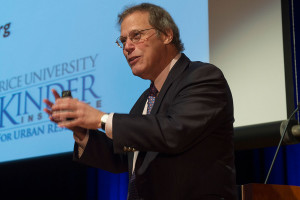Rice University’s Kinder Institute for Urban Research is releasing the new edition of its emblematic Houston Area Survey this week.
This year marks the 35th year of the survey, which, under the leadership of Dr Stephen Klineberg, has made findings that have helped understand Houston’s evolution since 1982.
 “This is a city self-consciously reinventing itself for the 21st century and you can see it across the board,” says Klineberg, founding director of the Kinder Institute and professor of sociology at Rice.
“This is a city self-consciously reinventing itself for the 21st century and you can see it across the board,” says Klineberg, founding director of the Kinder Institute and professor of sociology at Rice.
For him, Houston’s demographic transformation is one of the main topics the surveys have helped to track.
But there are other topics, such as the need to better prepare Houston’s population for the modern labor market and the desire to make the city more appealing in terms of quality of life and respect for the environment.
Those are topics the city and its leaders are working to address.
For example, the Greater Houston Partnership has the “UpSkill Houston” program, which promotes careers that require less than a four year college degree.
“A great example of the kinds of jobs we’re talking about can be found in the petrochemical industry, where there are many jobs like process operators and instrumentation technicians, that if they go to one of the local community colleges and get a two year degree, can go into those jobs and start at $60 or 70,000 as a starting salary and grow from there,” explains Peter Beard, senior vice president for Regional Workforce Development with the partnership.
As for the growth in diversity of the population, Klineberg emphasizes that Harris County has one of the most even distribution of Anglos, Hispanics, African-Americans and Asians.
Dr. Lloyd Potter, Texas state demographer and director of the Institute for Demographic and Socioeconomic Research and the Texas State Data Center at the University of Texas at San Antonio, notes in this regard that Houston has experienced an interesting shift “in terms of the composition of the population, their background, experience, the kind of jobs that people are working in.”
Regarding the goal of becoming a more environmentally-friendly city, the surveys have found there is support for projects that provide an effective co-existence of office buildings, the world’s biggest medical complex and large petro-chemical facilities with parks and green spaces.
That’s the objective of the Bayou Greenways plan, which will create a continuous parks system along Houston’s major waterways.
“We’re connecting green belts along all those bayous so that we connect employment centers, neighborhoods, schools, everybody in the city gets green space. And, why is that important? That’s important because we are in a national competition to attract and retain the best talent,” notes Tom Bacon, chairman of the Houston Parks Board Chairman, which is in charge of the project, in collaboration with the City of Houston’s Department of Parks and Recreation and the Harris County Flood Control District.